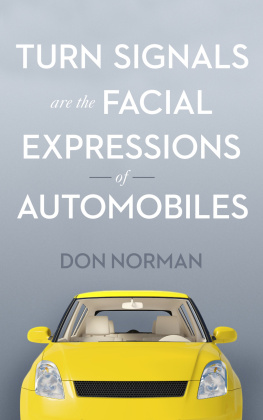PREFACE
This book is about the nature of human facial expressions. It provides a scientific account of human faces that squares with modern evolutionary theory.
In Human Facial Expression, I discuss contemporary theories of human expressions and emotions, methods and findings in ontogenyphylogeny relations, interactions of genes and culture, animal signaling, and so forth, all with the intent to discover what they can teach us about the face.
I also survey much of the literature on human faces and try to clarify how facial displays relate to reflexes, motives and intentions, emotion and its phenomenology and psychophysiology, and language and paralanguage. Along the way I touch on relevant topics from zoology, physiology, anthropology, sociology, and linguistics. This survey cannot be exhaustive, but I hope that it is representative.
This is the review aspect of the book, which should find it a home as a graduate or advanced undergraduate text. But it is just as much a manifesto for a newand to some, a heterodoxway to understand human faces; its behavioral ecology approach explains how faces function in everyday interaction, and reestablishes their connections with the signals of our extended kin in the animal world.
Human Facial Expression is not and cannot be just about facial expressions. From the theologians who saw our faces as windows on the soul, to the artists and physiognomists who used them to judge character, and to the clinicians and researchers who saw emotions revealed in them, faces were always more than movable bone, muscle, and flesh. Our faces always meant something transcendental; they have always said something about us. The behavioral ecology view found in these pages is no exception. We are, it holds, thoroughly social, so that when we gaze at others faces, we see not revelations of soul, character, or emotionbut declarations of their intentions toward us, and reflections of ours toward them. Our faces, together with our language, are social tools that help us navigate the social encounters that define our selves and fashion our lives. This is transcendentalism of a different sort.
ACKNOWLEDGMENTS
I began this book at the University of Pennsylvania in 1986, where I met several scholars who shook the scales from my eyes and forced me to take a fresh look at the face and what it said about ourselves. They have become good friends and supportive colleagues:
Avery Gilbert taught me what behavioral ecology is all about, and helped me understand how to extend an evolutionary view of displays to human faces;
Paul Rozin shared his knowledge of biology and cultural anthropology, and showed me that scholarship was compatible with humor;
John Sabini kept badgering me to clarify my concepts and would have been guilty of sophistry were he not always right;
and John Smith, who with kindness and a twinkle in his eye, shared his far-reaching vision of contemporary ethology.
Many other colleagues along the way have been kind and generous in sharing their work and their thinking. They include: Bernard Apfelbaum, Janet Beavin Bavelas, Don Brown, Joseph Campos, Nicole Chovil, Leda Cosmides, Robert DeRubeis, Phoebe Ellsworth, Alan Fiske, Stephen Fowler, Gerald Ginsburg, Henry Gleitman, Barbara Ivins, Adam Kendon, Richard Lazarus, Arnold Leiman, George Mandler, Peter Marler, Miles Patterson, David Premack, Gary Schwartz, Robert Seyfarth, Jay Shulkin, Craig Smith, Donald Symons, John Tooby, Philip Walker, and David Williams. I also thank Paul Ekman, Carroll Izard, and Gary Schwartz, who started me thinking about faces and supported and encouraged me early on.
Dick Jennings did me great kindness in publishing a prcis of this work in Biological Psychology. Marc Boggs was wonderfully gracious in remembering an old acquaintance. Nikki Fine, Steven Martin, and Sharon Hartley at Academic Press were wise and patient editors, who always knew what to do.
Jim Russell generously allowed me to include his masterful chapter on cross-cultural studies of faces, and provided many, many helpful comments. The editorial staff at InfoWorld, especially Carla Mathews, Jeff Senna, and Anne Kaliczak, were immensely supportive in providing me the software to do the illustrations.
Finally, my deepest thanks to my wife, partner, and colleague, Amy Jaffey, who endured my authors monomania and returned love, support, canny intellectual criticism, and the best son a father could haveand to Jason, who napped just enough to let me finish.
To all these people, thanks.
Alan J. Fridlund
PRE-DARWINIAN VIEWS ON FACIAL EXPRESSION
Publisher Summary
Physiognomy was the classical practice of facial morphology or face reading. Even during earlier periods when physiognomy was especially in vogue, the belief was pervasive that the face was the window to the soul. This tradition of classical physiognomy characterized traits from the conformation of the face despite the range of factors that may have produced it. The range of facial morphological contortions that were visible to the observer, that Leibniz labeled as passions, were believed to give away a persons true feelings. Until the nineteenth century, interest in the face was primarily morphological and physiognomic, and most observers abided by Aristotles skepticism about whether fleeting facial movements were at all worth studying. Thereafter, interest in facial movements grew as the result of a number of factors. Pre-Darwinian evolutionists attempted explanations to account for facial muscular actions; pre-Darwinian evolutionist Lorenz Oken believed that the bones and muscles of the head were but transformed extremities. While, Charles Bell in his Essays on the anatomy of expression in painting, 1806, attempted to explain facial actions simply as indicating pleasant versus unpleasant sentiments. Darwins account of facial expression attempted to link icon like faces with discrete basic emotions. Darwins attack took the form of a volume on the face and emotion, the Expression of the emotions in man and animals.
The current practice of reading emotion in the human face is only the most recent of many. Preoccupation with facial morphology came first, in the practice of face-reading known as









